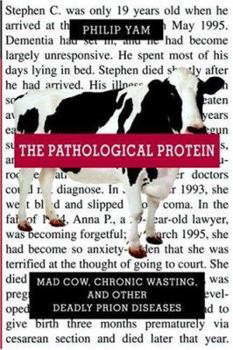The Pathological Protein: Mad Cow, Chronic Wasting, and Other Deadly Prion Diseases
Select Format
Select Condition 
Book Overview
Prion diseases have plagued humans and animals for 3 centuries, but only in the last 2 decades have researchers linked them to diseases like Mad Cow. Yam's tale of medical sleuthing tells the story.
Format:Hardcover
Language:English
ISBN:0387955089
ISBN13:9780387955087
Release Date:April 2003
Publisher:Copernicus Books
Length:286 Pages
Weight:1.40 lbs.
Dimensions:1.1" x 6.5" x 9.6"
Customer Reviews
5 ratings
A great introduction to prions!
Published by Thriftbooks.com User , 18 years ago
This book is a balanced, engaging introduction to the prion diseases. Philip Yam does a great job of presenting the varieties of views on BSE, CJD, and Kuru, and makes it clear to the reader that there are many riddles yet to be solved, and there is still a great deal of controversy surrounding these diseases. However, he does not spend the entire book focusing on the controversy, and proceeds to delve into the details of prion theory, and possible therapeutic options. Yam does a wonderful job of presenting the topic, and continues to provide stimulating and novel information on every page!
Easily the best book of its kind
Published by Thriftbooks.com User , 20 years ago
Philip Yam's book The Pathological Protein is easily the best book of its kind. Written in clear, simple language for the non-specialist audience, The Pathological Protein is a thoroughly comprehensive, concise and, above all, scientifically accurate review of BSE and related diseases. Yam has been writing and editing for Scientific American since 1989 and this, his first book, demonstrates the high standard to which all science writers ought to aspire. The first chapter of The Pathological Protein describes, from a very human perspective, the effects of variant Creutzfedt-Jakob disease on one victim, 19 year-old Stephen Churchill, and his family. From this tragedy, Yam then goes on to review the history of CJD and the mysterious diease 'kuru', which reached epidemic proportions amongst the Fore people of Papua-New Guinea because of their cannibalistic funerary rites. After discussing the hereditary transmissible spongiform encephalopathies (TSEs) of humans, outlines what is known of the TSEs of animals. Philip Yam's reviews of scrapie, BSE, transmissible mink encephalopathy and chronic wasting disease are up-to-date, interesting, and extremely readable.There is an interesting episode related in the book. Carlton Gajdusek had been searching, unsuccesfully, for the cause of kuru. William Hadlow, and American scrapie researcher on a secondment to the United Kingdom, visited the Wellcome Medical Museum in London to look at a display on kuru that Gajdusek had prepared. It was Hadlow who first noticed the very close resemblance between kuru and scrapie. The similarities in epidemiologic features, general clinical pattern and the neurohistologic changes led him to the realisation that these diseases were probably mmebers of the same family. As a result of Hadlow's insight transmission experiments were started which, eventually, led to our current understanding of the TSEs This book covers the hypotheses for the origins of BSE, the evidence for the link between BSE and vCJD, current methods and problems of diagnosis of the TSEs, and the search for cures. Philip Yam clearly is thoroughly versed in the scientific literature of the TSEs, but also interviewed a broad range of scientists, consumers advocates and regulators. So, he knows what he is writing about, and this is made evident by the clarity and accuracy of his explanations. Although there is no 'dumbing down' of a difficult and complex subject, the author has written a book which makes his subject easily accessible to the non-specialist reader. The book is referenced, well indexed, has a useful glossary and also suggests sources for further information, including the more useful web sites and organisations providing suport and help for families of CJD victims. While the book is written for the interested lay person, I would have no hesitation in recommending Philip Yam's The Pathological Protein to veterinarians and colleagues who want an interesting, thorough and current review of these fascinati
A must read for a better understanding of mad cow disease!
Published by Thriftbooks.com User , 20 years ago
An easy read even for people without a scientific background. The author takes you through a thorough exploration of the threats of mad cow and other related diseases. You may never look at beef the same way again.
An engaging and important read!
Published by Thriftbooks.com User , 20 years ago
Particularly now that mad cow disease has been found in the US, "The Pathological Protein" is an important and engaging read. The book covers not only mad cow disease and its human form, variant Creutzfeldt-Jakob's disease, but it also covers the underlying cause: misfolded proteins called prions. Yam explains different types of prion diseases and discusses the researchers that have been striving to understand the prion and control the devistating neurological illnesses it causes. Yam discusses the safety of beef today and what could be done to stem the rise in mad cow disease. Well-researched, exceptionally well-written, and highly recommended!
This is a book you should read
Published by Thriftbooks.com User , 20 years ago
Protecting the quality of U.S. beef is a concern for each of us individually and for the economy. The Pathological Protein is a good read, a great source of valuable information about prion diseases, and an important guide to some very questionable areas of meat producing.




